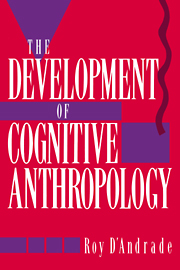Book contents
- Frontmatter
- Contents
- List of figures
- List of tables
- Preface
- 1 Background
- 2 Towards an analysis of meaning
- 3 The classic feature model
- 4 Extension of the feature model
- 5 Folk taxonomies
- 6 The growth of schema theory
- 7 Models and theories
- 8 Cultural representations and psychological processes
- 9 Cognitive processes and personality
- 10 Summing up
- References
- Name index
- General index
4 - Extension of the feature model
Published online by Cambridge University Press: 05 June 2012
- Frontmatter
- Contents
- List of figures
- List of tables
- Preface
- 1 Background
- 2 Towards an analysis of meaning
- 3 The classic feature model
- 4 Extension of the feature model
- 5 Folk taxonomies
- 6 The growth of schema theory
- 7 Models and theories
- 8 Cultural representations and psychological processes
- 9 Cognitive processes and personality
- 10 Summing up
- References
- Name index
- General index
Summary
Firewood
Kin terms served as an exemplary domain for investigation of the way semantic features can be related to short-term memory, analogy, polysemy, similarity ratings, and other cognitive phenomena. Necessarily, these findings depend on being able to determine the features of the terms. The techniques described in the preceding chapters for determining the features of kin terms had a long history of development. Out of years of research on kin terms came the techniques developed by Lounsbury, Goodenough, Romney, Hammel, Atkins and others which gave a high degree of precision to the feature analysis of kin terms; although there might be disputes about certain complex configurations, in general a high degree of consensus was obtained in the analysis of kin term systems.
Kin terms, however, are only one small terminological domain in the lexicon of any language. What about all the other domains which did not have the paradigmatic character of kinship terminologies? The question quickly arose as to whether the same kind of feature model could be applied to other domains of cultural meaning. The feature model might be quite important theoretically, but if it could only be applied to kin terms it would be of very limited use. Most of these other domains, however, had no long history of semantic analysis. To get at the feature structure of these new domains new methods had to be developed.
Information
- Type
- Chapter
- Information
- The Development of Cognitive Anthropology , pp. 58 - 91Publisher: Cambridge University PressPrint publication year: 1995
